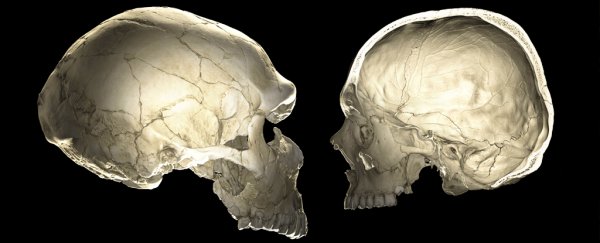Scattered among your genes like old recipes in an heirloom cookbook are DNA sequences that once helped Neanderthals survive.
The codes that contributed to the construction of our extinct cousin's ever-so-slightly elongated skulls could still be at work in some modern humans, affecting neurological development and pushing their craniums into a slightly different shape.
Neanderthals get a pretty bad rap as lantern-jawed cavemen. Far from being pea-brains, they had longer skulls filled with slightly more grey matter than those of our own immediate ancestors.
That didn't necessarily make them geniuses. But it does raise some questions on how and why our own brains evolved to be so globular, or round, by comparison.
Geneticist and neurologist Amanda Tilot from the Max Planck Institute for Psycholinguistics recently co-led a study probing the mystery of our respective brains by searching for Neanderthal genes still in circulation.
"Our aim was to identify potential candidate genes and biological pathways that are related to brain globularity," says Tilot.
Given the gooey insides of Neanderthal heads have long since rotted away, we can only guess what their brains were like by making casts of the hollow area inside their fossilised skulls.
By comparing those casts with ones taken of modern human skulls, we can see more than gross differences in average volume and proportions.
Past research has identified some pretty significant contrasts in the sizes of our cerebella, for example.
Data from those past studies has now been used to show there might also be big differences in our prefrontal cortices, as well as our occipital and temporal lobes.
"We captured subtle variations in endocranial shape that likely reflect changes in the volume and connectivity of certain brain areas," says Max Planck Institute for Evolutionary Anthropology paleoanthropologist Philipp Gunz, who co-led the research with Tilot.
We humans are pretty enamoured with our intelligence, so we're keen to learn how our smarts came about in the first place.
Our evolution can be traced back some 300,000 years to the African continent, where diverse human populations spread across the land exchanged characteristics that we now think of as being quintessentially Homo sapien.
The direct ancestors of Neanderthal populations wandered off a little earlier, splitting from our shared family tree anywhere from around 400,000 to 800,000 years ago.
That means – in theory – their bodies represent a set of unique modifications of a slightly older model of brain box. Comparing our skulls with theirs could therefore hint at evolutionary nudges that shaped our brains.
Of course, nature is never so simple. Neanderthals and our direct ancestors didn't always stick to their own branch of the family tree, swapping genes through frequent cross-hybridisation.
The legacy of this genetic mixing persists to this day, with roughly 1 percent of our genes having originating in Neanderthal populations.
Measuring the distribution and influences of those genes could tell us how and why they evolved. Some probably stuck around because they helped us deal with disease, for example.
The researchers gathered genetic information and MRI data on just under 4,500 individuals with European ancestry, giving them a database of skull measurements and genomes.
Comparing the two lists of figures led the team to a pair of known Neanderthal code fragments which appear to determine the degree of skull globularity.
One of them is understood to influence the gene UBR4, which is involved in generating new brain cells. The second affects the function of the gene PHLPP1, which has a hand in insulating neurons in what's known as a myelin sheath.
"We know from other studies that completely disrupting UBR4 or PHLPP1 can have major consequences for brain development," says geneticist Simon Fisher.
"Here we found that, in carriers of the relevant Neanderthal fragment, UBR4 is slightly down-regulated in the putamen. For carriers of the Neanderthal PHLPP1 fragment, gene expression is slightly higher in the cerebellum, which would be predicted to have a dampening effect on cerebellar myelination."
Both of these regions play a key role in learning and coordinating movement. The putamen in particular sits within a network that affects memory, speech, and attention.
Carrying these genes doesn't mean we have humans who think like Neanderthals. Their influence is too subtle to be detected on an individual level.
But thrown into a growing pool of evidence describing our brain's evolution, it just might help us better understand the selective forces that helped give our ancestors the edge.
This research was published in Current Biology.
